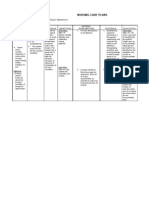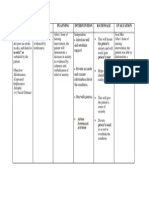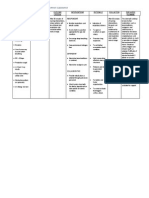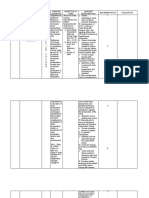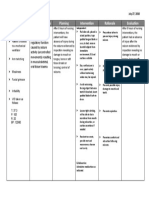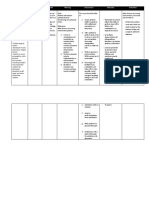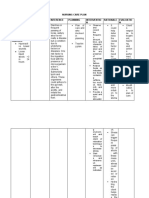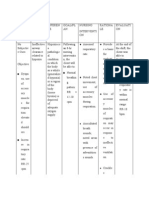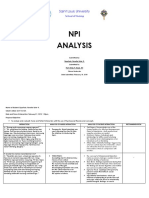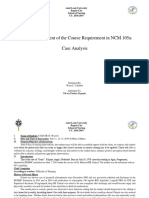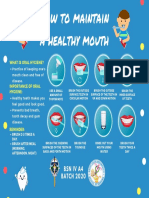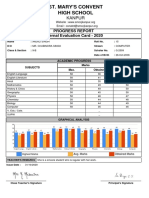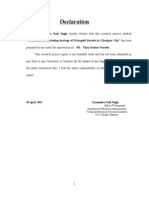0 ratings0% found this document useful (0 votes)
874 viewsNCP Tbi
NCP Tbi
Uploaded by
Wyen CabatbatThe nursing care plan addresses a client experiencing hypoxia and ineffective airway clearance. Goals include improving ventilation and respiratory status. Interventions include assessing respiratory rate and sounds, providing oxygen, positioning, and evaluating response. A second client has increased blood pressure from intracranial pressure and vasoconstriction. Goals are to decrease blood pressure through rest, diet, medication and monitoring. A third client has a risk of brain injury. Goals are understanding risk factors and taking steps to correct them through education on disease, monitoring, and providing information.
Copyright:
© All Rights Reserved
Available Formats
Download as DOCX, PDF, TXT or read online from Scribd
NCP Tbi
NCP Tbi
Uploaded by
Wyen Cabatbat0 ratings0% found this document useful (0 votes)
874 views4 pagesThe nursing care plan addresses a client experiencing hypoxia and ineffective airway clearance. Goals include improving ventilation and respiratory status. Interventions include assessing respiratory rate and sounds, providing oxygen, positioning, and evaluating response. A second client has increased blood pressure from intracranial pressure and vasoconstriction. Goals are to decrease blood pressure through rest, diet, medication and monitoring. A third client has a risk of brain injury. Goals are understanding risk factors and taking steps to correct them through education on disease, monitoring, and providing information.
Original Title
NCP TBI.docx
Copyright
© © All Rights Reserved
Available Formats
DOCX, PDF, TXT or read online from Scribd
Share this document
Did you find this document useful?
Is this content inappropriate?
The nursing care plan addresses a client experiencing hypoxia and ineffective airway clearance. Goals include improving ventilation and respiratory status. Interventions include assessing respiratory rate and sounds, providing oxygen, positioning, and evaluating response. A second client has increased blood pressure from intracranial pressure and vasoconstriction. Goals are to decrease blood pressure through rest, diet, medication and monitoring. A third client has a risk of brain injury. Goals are understanding risk factors and taking steps to correct them through education on disease, monitoring, and providing information.
Copyright:
© All Rights Reserved
Available Formats
Download as DOCX, PDF, TXT or read online from Scribd
Download as docx, pdf, or txt
0 ratings0% found this document useful (0 votes)
874 views4 pagesNCP Tbi
NCP Tbi
Uploaded by
Wyen CabatbatThe nursing care plan addresses a client experiencing hypoxia and ineffective airway clearance. Goals include improving ventilation and respiratory status. Interventions include assessing respiratory rate and sounds, providing oxygen, positioning, and evaluating response. A second client has increased blood pressure from intracranial pressure and vasoconstriction. Goals are to decrease blood pressure through rest, diet, medication and monitoring. A third client has a risk of brain injury. Goals are understanding risk factors and taking steps to correct them through education on disease, monitoring, and providing information.
Copyright:
© All Rights Reserved
Available Formats
Download as DOCX, PDF, TXT or read online from Scribd
Download as docx, pdf, or txt
You are on page 1of 4
At a glance
Powered by AI
The key takeaways are that brain injuries can be caused by both internal and external factors and occur due to a wide range of reasons. Common causes include physical trauma, head injury, disorders, and congenital maladies.
Common causes of brain injuries include traumatic brain injury from physical trauma or head injury, increased intracranial pressure, and brain damage from disorders or conditions like hypoxia.
Factors that contribute to the risk of injury include individual lifestyle choices, medical conditions, and situations that could result in physical harm.
NURSING CARE PLAN
CUES NURSIN INFEREN GOAL/PL NURSING RATIONA EVALUATI
G CE AN INTERVENTI LE ON
DIAGNO ON
SIS
No Ineffective Hypoxia is Following Assessed Provide At the end of
Subjectiv airway a an 8-hr respiratory s a basis the shift, the
e Cues clearance pathologic nursing rate. for client was
related to al interventio evaluati able to
Objective hypoxia. condition n, the ng display
: in which client will adequac patency of
Dyspn the body be able to: Noted chest y of airway as
ea; use as a whole Normal movement; ventilati manifested
of (generalize breathin use of on. by:
access d hypoxia) g accessory Client’s
ory or a region pattern: muscles Use of respirator
muscle of the RR = during accessor y rate is
s for body 12-20 respiration. y within
respira (tissue cpm muscles normal
tion: hyoxia) is of range:
elevate deprived Auscultated respirati RR-18
d of breath on may bpm.
should adequate sounds; occur in
ers. oxygen noted areas respons
Increa supply. with e to
se in presence of ineffecti
respira adventitiou ve
tory s sounds. ventilati
rate: on.
RR-25
cpm Crackle
s
indicate
accumul
ation of
secretio
ns and
inability
to clear
airways.
CUES NURSING INFERENC GOAL/PL NURSING RATION EVALUAT
DIAGNOSI E AN INTERVEN ALE ION
S TION
No Ineffective Increased After 4 > Monitored > To > After 4
Subjective cerebral cardiac hours of blood know the hours of
Cues tissue output that nursing pressure base line nursing
perfusion injures the interventio every 4hours. of BP > intervention
related to endothelial n the pt > Instructed Sodium the
Objective: increased cells of the blood to have tends to be patient’s
PR = 85 intracranial arteries and pressure enough rest excreted at blood
bpm pressure the action of will on semi a faster pressure
RR = 30 and prostaglandi decrease fowlers rate. was
bpm vasoconstri ns. from 160/ position. > decreased
160/100m ction of Vasoconstri 100mmHg Instructed to > To from
mHg blood ction occurs to eat low fat reduce 160/100mm
vessels and blood 120/80mm and low salt edema that Hg to
pressure Hg. diet. > may 140/90mm
increases. Administered activate Hg.
anti- renin
hypertensive angiotensi
drug as n-
ordered. aldosteron
e system.
> To
control the
BP and to
avoid
other
complicati
ons.
CUES NURSING INFEREN GOAL/PL NURSING RATIONA EVALUATI
DIAGNO CE AN INTERVENTI LE ON
SIS ON
No Risk for Brain After 3 Monitor •To assess After 3 hours
Subjecti injury damage or hours of peripheral baseline of nursing
ve Cues related to "brain nursing pulses and data intervention,
brain injury" interventio vital signs, •To assist the client
damage. (BI); n, the client especially the client to verbalized
Objectiv means the will be able heart rate reduce or understandin
e: destruction to verbalize every hour to correct g of
T: 36.7 or understandi every four individual individual
PR: 65 degenerati ng of hours risk factor. factors that
bpmRR: on of brain individual depending on contribute to
18 cells, often factors that the client’s possibility of
cpmBP: with an contribute condition. injury and
120/70 implication to • take steps to
mmHg that the possibility Provide correct
loss is of injury information situations.Go
significant and take regarding al was met
in terms of steps to disease/conditi
functionin correct on that may
g or situations result in
conscious increased risk
experience of injury.
. It is a
common
and very
broad in
scope,
such that
in
medicine a
vast range
of specific
diagnoses
exist.
Brain
injuries
occur due
to a wide
range of
internal
and
external
factors. A
common
category
with the
greatest
number of
injuries is
traumatic
brain
injury
(TBI)
following
physical
trauma or
head injury
from an
outside
source, and
the term
acquired
brain
injury
(ABI) is
used in
appropriate
circles, to
differentiat
e brain
injuries
occurring
after birth
from
injury due
to a
disorder or
congential
malady.
You might also like
- Burroughs - Port of SaintsDocument174 pagesBurroughs - Port of Saintsjan mullerNo ratings yet
- Idoc - Pub Nursing Care Plan For Seizure NCPDocument2 pagesIdoc - Pub Nursing Care Plan For Seizure NCPACERET, IVAN LAURENTINE G.No ratings yet
- Hyperthermia (Thurs)Document1 pageHyperthermia (Thurs)Christine Esguerra OrozcoNo ratings yet
- Acute Coronary Syndrome - Concept MapDocument1 pageAcute Coronary Syndrome - Concept MapWyen CabatbatNo ratings yet
- NCP - NewbornDocument1 pageNCP - NewbornChristine Michelle A. BalancadNo ratings yet
- Migraine NCPDocument5 pagesMigraine NCPJohn Dexter FranciscoNo ratings yet
- NCP-Septic Shock (Acute Pain)Document3 pagesNCP-Septic Shock (Acute Pain)Ted anadiloNo ratings yet
- Nursing Care PlanDocument2 pagesNursing Care Planseeker009No ratings yet
- Cues Nursing Diagnosis Analysis Goal Nursing Intervention Rationale EvaluationDocument5 pagesCues Nursing Diagnosis Analysis Goal Nursing Intervention Rationale Evaluationccchelle14No ratings yet
- Nursing Care Plan: Subjective DataDocument4 pagesNursing Care Plan: Subjective DataAbdallah AlasalNo ratings yet
- Student Nurses' Community: Nursing Care Plan AmputationDocument3 pagesStudent Nurses' Community: Nursing Care Plan AmputationNur faizah bt azmiNo ratings yet
- NCP For Cervical SpondylosisDocument3 pagesNCP For Cervical Spondylosishannah0% (1)
- NCP - Multiple BruisesDocument3 pagesNCP - Multiple BruisesLeogalvez BedanoNo ratings yet
- NCPDocument2 pagesNCPJhel NabosNo ratings yet
- NCP On DyspneaDocument5 pagesNCP On DyspneaDizzy BualanNo ratings yet
- Ineffective Tissue PerfusionDocument2 pagesIneffective Tissue Perfusionsyderman999No ratings yet
- BPN NCPDocument6 pagesBPN NCPJoart EspinozaNo ratings yet
- Nursing Care Plan On SepsisDocument6 pagesNursing Care Plan On SepsisleoNo ratings yet
- NCP BMDocument1 pageNCP BMSourabh MehraNo ratings yet
- Cva NCP AnxietyDocument1 pageCva NCP AnxietyQueenElsaDeVeraNo ratings yet
- NCP 1 1Document10 pagesNCP 1 1Samantha VeraNo ratings yet
- Chronic Renal Failure Nursing Care PlanDocument6 pagesChronic Renal Failure Nursing Care PlanRuva Oscass JimmyNo ratings yet
- NCP-Ineffective Cerebral Tissue PerfusionDocument9 pagesNCP-Ineffective Cerebral Tissue PerfusionKarel LuNo ratings yet
- NCP Ineffective Breathing PatternDocument4 pagesNCP Ineffective Breathing PatternSeika SouiNo ratings yet
- Nursing Care Plan Impaired CommunicationDocument3 pagesNursing Care Plan Impaired CommunicationRamiel ChristopherNo ratings yet
- Nursing Care PlanDocument3 pagesNursing Care PlanCspc Crcyc50% (2)
- Nursing Care Plan: Assessment Diagnosis Planning Interventions Rationale EvaluationDocument1 pageNursing Care Plan: Assessment Diagnosis Planning Interventions Rationale EvaluationJhevilin RM100% (1)
- Nursing Intervention (Epiglottitis Disease)Document2 pagesNursing Intervention (Epiglottitis Disease)Marianne Rose HernandezNo ratings yet
- Assessment Nursing Diagnosis Planning Implementation Rationalization Evaluation Subjective: Short Term Goal: Independent Goal MetDocument1 pageAssessment Nursing Diagnosis Planning Implementation Rationalization Evaluation Subjective: Short Term Goal: Independent Goal MetKelsey MacaraigNo ratings yet
- NCP - Ineffective Airway ClearanceDocument2 pagesNCP - Ineffective Airway ClearanceKhat100% (1)
- Impaired Physical MobilityDocument2 pagesImpaired Physical MobilityJayson OlileNo ratings yet
- NCP For Parent and Child PDFDocument3 pagesNCP For Parent and Child PDFMariana Mikaela AlagarNo ratings yet
- Risk For SuffocationDocument2 pagesRisk For SuffocationKimberly Subade Mandilag100% (2)
- DIAGNOSIS Hyperthermia Related To Increased Metabolic Rate, Illness. ASSESSMENT SubjectiveDocument1 pageDIAGNOSIS Hyperthermia Related To Increased Metabolic Rate, Illness. ASSESSMENT Subjectivemawel100% (1)
- NCP For ConcussionDocument3 pagesNCP For Concussiontamtam_antonio100% (1)
- Gender Dysphoria NCPDocument1 pageGender Dysphoria NCPSeann LorescoNo ratings yet
- NCP AneurysmDocument4 pagesNCP AneurysmJanielle Christine Monsalud100% (1)
- Pleural EffusionDocument5 pagesPleural EffusionTerizla MobileNo ratings yet
- BibliographyDocument10 pagesBibliographySourav Kumar Patra100% (1)
- Otitis Media AcuteDocument30 pagesOtitis Media AcuteDede Gustina AyuNo ratings yet
- Resulting in Damage To Brain Tissue.: Definition: Independent: IndependentDocument4 pagesResulting in Damage To Brain Tissue.: Definition: Independent: Independentalliahjoyce ignacioNo ratings yet
- NCP HyperthermiaDocument3 pagesNCP HyperthermiaPrincess Alane MorenoNo ratings yet
- TB, Ineffectivbe Breathing PatternsDocument1 pageTB, Ineffectivbe Breathing PatternsnikkilyceeNo ratings yet
- Assessment Diagnosis Planning Nursing Intervention Rationale EvaluationDocument2 pagesAssessment Diagnosis Planning Nursing Intervention Rationale Evaluationjennelyn losantaNo ratings yet
- NCP Close Complete Fracture Knowledge DeficitDocument2 pagesNCP Close Complete Fracture Knowledge DeficitArt Christian Ramos0% (1)
- Risk For InjuryDocument1 pageRisk For Injuryandycamille7No ratings yet
- Spina Bifida NCPDocument3 pagesSpina Bifida NCPShahzad GulfamNo ratings yet
- Breast Mass Bilateral To Consider FibroadenomaDocument5 pagesBreast Mass Bilateral To Consider FibroadenomaYum CNo ratings yet
- Acute PainDocument3 pagesAcute PainJayr ChinNo ratings yet
- Assessment Objectives: "Masakit Lagi Yung Lalamunan NyaDocument3 pagesAssessment Objectives: "Masakit Lagi Yung Lalamunan Nyaangel_pearl413100% (2)
- Nursing Care Plan Ineffective Breathing Pattern Hepatic MassDocument2 pagesNursing Care Plan Ineffective Breathing Pattern Hepatic MassRheegell Ellar-Fuertes100% (3)
- Nursing Care PlanDocument3 pagesNursing Care PlanAnnahNo ratings yet
- Nursing Care Plan Assessment Diagnosis Inference Planning Interventio N Rationale Evaluatio N SubjectiveDocument58 pagesNursing Care Plan Assessment Diagnosis Inference Planning Interventio N Rationale Evaluatio N SubjectiveJemina Rafanan RacadioNo ratings yet
- "Mayroong Namuong Dugo Sa Utak Niya Kaya Hindi Maayos Ang Daloy NG Dugo Rito" As Verbalized by The Patient's MotherDocument6 pages"Mayroong Namuong Dugo Sa Utak Niya Kaya Hindi Maayos Ang Daloy NG Dugo Rito" As Verbalized by The Patient's MotherAllisson BeckersNo ratings yet
- Nursing Diagnosis Goal Interventions Expected Outcome: (List 5 Unique To The Given Nursing DX)Document3 pagesNursing Diagnosis Goal Interventions Expected Outcome: (List 5 Unique To The Given Nursing DX)joyrena ochondraNo ratings yet
- NCP OsteomyelitisDocument6 pagesNCP OsteomyelitisRenie SerranoNo ratings yet
- Nursing Care PlanDocument3 pagesNursing Care Planjnx_anonymousNo ratings yet
- Final NCP LeptospirosisDocument6 pagesFinal NCP LeptospirosisKeith Austin100% (1)
- Ventricular Septal Defect, A Simple Guide To The Condition, Treatment And Related ConditionsFrom EverandVentricular Septal Defect, A Simple Guide To The Condition, Treatment And Related ConditionsNo ratings yet
- Nursing Care Plan TBIDocument5 pagesNursing Care Plan TBIChester Manalo87% (15)
- Name: Mr. M AGE: 62 Years Old SEX: Male CC: Persistent Cough Admitting/Working Diagnosis: PnuemoniaDocument3 pagesName: Mr. M AGE: 62 Years Old SEX: Male CC: Persistent Cough Admitting/Working Diagnosis: PnuemoniaMae Therese B. MAGNONo ratings yet
- NCPDocument27 pagesNCPcuakialyannaNo ratings yet
- MCQ For FLuid and ElectrolytesDocument10 pagesMCQ For FLuid and ElectrolytesWyen Cabatbat100% (1)
- Triage NotesDocument5 pagesTriage NotesWyen Cabatbat67% (3)
- Nursing Problem Prioritization - CAPDocument16 pagesNursing Problem Prioritization - CAPWyen Cabatbat100% (1)
- Geron - Story of Mamang & TatangDocument1 pageGeron - Story of Mamang & TatangWyen CabatbatNo ratings yet
- ER Journal Summary - Effects of An Ethical Empowerment Program On Critical Care Nurses' Ethical Decision-MakingDocument1 pageER Journal Summary - Effects of An Ethical Empowerment Program On Critical Care Nurses' Ethical Decision-MakingWyen CabatbatNo ratings yet
- NPI Analysis: Saint Louis UniversityDocument3 pagesNPI Analysis: Saint Louis UniversityWyen CabatbatNo ratings yet
- Pathophysiology (Simple) - Hodgkins LymphomaDocument1 pagePathophysiology (Simple) - Hodgkins LymphomaWyen CabatbatNo ratings yet
- Prioritization FNCPDocument3 pagesPrioritization FNCPWyen CabatbatNo ratings yet
- Journal:: Mental Health and Emotional Sphere of Women in The Postnatal PeriodDocument4 pagesJournal:: Mental Health and Emotional Sphere of Women in The Postnatal PeriodWyen CabatbatNo ratings yet
- Case Analysis - Paranoid SchizophreniaDocument7 pagesCase Analysis - Paranoid SchizophreniaWyen CabatbatNo ratings yet
- FDAR Charting - SurgicalDocument1 pageFDAR Charting - SurgicalWyen CabatbatNo ratings yet
- FDAR Charting - Readiness For Enhanced ComfortDocument1 pageFDAR Charting - Readiness For Enhanced ComfortWyen Cabatbat100% (1)
- Case Analysis - Paranoid SchizophreniaDocument7 pagesCase Analysis - Paranoid SchizophreniaWyen CabatbatNo ratings yet
- Oral Hygiene PDFDocument1 pageOral Hygiene PDFWyen CabatbatNo ratings yet
- Case Pres A1 SurgDocument14 pagesCase Pres A1 SurgWyen CabatbatNo ratings yet
- Prospects of Ecotourism in Bangus Valley J&K: Abdul Hamid Mir Dr. Ateeque AhmedDocument5 pagesProspects of Ecotourism in Bangus Valley J&K: Abdul Hamid Mir Dr. Ateeque AhmedishfaqqqNo ratings yet
- Anjali 2951 2020-2021 Term-1Document1 pageAnjali 2951 2020-2021 Term-1Anjali Singh //10 B 05No ratings yet
- Luran 368R: Technical DatasheetDocument3 pagesLuran 368R: Technical DatasheetVictor PuertoNo ratings yet
- Solid EnvironmentDocument19 pagesSolid EnvironmentMaRiz BalitaanNo ratings yet
- Planning An Investigation Model Answers Five Complete PlansDocument16 pagesPlanning An Investigation Model Answers Five Complete PlansAhmad Kabil100% (1)
- Common Medical Abbreviations FormulaDocument3 pagesCommon Medical Abbreviations FormulaZyra DIOKNO0% (1)
- VIP-X System Manual 1v5 - 3Document114 pagesVIP-X System Manual 1v5 - 3AndresBohorquezNo ratings yet
- Libya Proposal - F550 LDR - 10113-0005Document30 pagesLibya Proposal - F550 LDR - 10113-0005Jabel Oil Services Technical DPTNo ratings yet
- J. Biol. Chem. 1963 de La Burde 189 97Document9 pagesJ. Biol. Chem. 1963 de La Burde 189 97Tran Duy ThanhNo ratings yet
- Autism Check ListDocument3 pagesAutism Check ListAswini DashNo ratings yet
- Dissertation Art and DesignDocument5 pagesDissertation Art and DesignBuyResumePaperUK100% (1)
- Camera F50 PDFDocument75 pagesCamera F50 PDFRicardo Martínez IbáñezNo ratings yet
- Ella Marie Mostrales - Task 6Document2 pagesElla Marie Mostrales - Task 6Ella Marie MostralesNo ratings yet
- Determination of Total Phenolic Content Using The Folin-C Assay: Single-Laboratory Validation, First Action 2017.13Document7 pagesDetermination of Total Phenolic Content Using The Folin-C Assay: Single-Laboratory Validation, First Action 2017.13Naye VillalónNo ratings yet
- Fluids SummaryDocument21 pagesFluids SummaryFelipe BarrosNo ratings yet
- Evaluation of Marketing Strategy of Priyagold Biscuits in Ghazipur City"Document76 pagesEvaluation of Marketing Strategy of Priyagold Biscuits in Ghazipur City"Prashant Singh50% (2)
- Project ProposalDocument17 pagesProject ProposalAmit MirjiNo ratings yet
- Lesson: Dr. Leon Hammer, M.DDocument8 pagesLesson: Dr. Leon Hammer, M.DRocío JMNo ratings yet
- Literary ThemesDocument36 pagesLiterary ThemesTeresita AbellonNo ratings yet
- Fire and Life Safety MeasuresDocument58 pagesFire and Life Safety MeasuresRhey LuceroNo ratings yet
- Hinawi Software All Modules - Summary - EnglishDocument6 pagesHinawi Software All Modules - Summary - EnglishHatem Said Al HinawiNo ratings yet
- LandscapeDocument9 pagesLandscapeyaredNo ratings yet
- San Teodoro National High School San Teodoro National High SchoolDocument3 pagesSan Teodoro National High School San Teodoro National High SchoolKen Ian Derick AcevedaNo ratings yet
- Maurice Hauriou - Harvard Law Rev - 1918Document10 pagesMaurice Hauriou - Harvard Law Rev - 1918fvillarolmedoNo ratings yet
- HACCP PRPs Document Templates IndexDocument8 pagesHACCP PRPs Document Templates IndexHamada AhmedNo ratings yet
- Wa0013Document5 pagesWa0013falgunsanadhyaNo ratings yet
- Industrial Pharmacy 7th Sem Important Questions B Pharm Shahruddin KhanDocument35 pagesIndustrial Pharmacy 7th Sem Important Questions B Pharm Shahruddin Khanammarahmad882002No ratings yet
- Computer Operator SadDocument1 pageComputer Operator SadxxvinnNo ratings yet
- Simple Present NitaDocument42 pagesSimple Present NitaAMIN NITANo ratings yet













